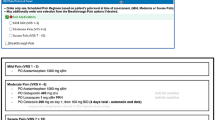Abstract
Background
Most patients with IBD experience pain, especially during acute disease exacerbations. Opioid use continues to be more prevalent in IBD than any other chronic gastrointestinal condition, and the majority of IBD patients consume narcotics during hospitalization despite the risks of infection and death.
Methods
We performed a retrospective review of 57 subjects aimed at quantifying pain and opiate consumption for IBD-related admissions over a 3-month period. For each patient, the average and maximum of each day’s pain scores were used to measure changes in pain from admission to discharge using mixed model regression, with opiate use as a time-dependent covariate.
Results
The daily average pain score over the entire hospitalization was 4.23 ± 2.09, and the maximum pain score was 8.28 ± 1.75. Among opioid users (n = 51), the daily average pain score was 4.65 ± 2.16 and the maximum pain score was 7.53 ± 2.56. Across all cases from admission to discharge, there was less than a 1-point change in daily average pain (− 0.96 ± 2.03, p = 0.0009), and no change in maximum pain (− 0.89 ± 3.59, p = 0.0671). Opioid users, a subset of the overall cohort, had a similar less than one-point drop in daily average pain (− 0.94 ± − 0.29, p = 0.0024) and no change in daily maximum pain scores (− 0.81 ± − 0.47, p = 0.0914). Patients on average used 20 ± 25 mg morphine equivalents per day. Opioid-naïve patients used similar doses to those who used opioids prior to admission (PTA). Almost half of all cases (47%) were discharged with an opioid prescription, the majority (71%) of whom were not on opioids PTA.
Conclusions
Pain in IBD is not well controlled through hospitalization, with less than a 1-point change from admission to discharge, despite significant opioid consumption. Alternative analgesic methods should be explored, given the significant impact of narcotics on long-term outcomes including mortality and quality of life.


Similar content being viewed by others
References
Zeitz J, Ak M, Muller-Mottet S, et al. Pain in IBD patients: very frequent and frequently insufficiently taken into account. PLoS One. 2016;11:e0156666. (Epub 06/23/2016).
Sweeney L, Moss-Morris R, Czuber-Dochan W, Meade L, Chumbley G, Norton C. Systematic review: psychosocial factors associated with pain in inflammatory bowel disease. Aliment Pharmacol Ther. 2018;47:715–729. (Epub 01/24/2018).
Schreiber S, Panes J, Louis E, Holley D, Buch M, Paridaens K. Perception gaps between patients with ulcerative colitis and healthcare professionals: an online survey. BMC Gastroenterol. 2012;12:108. (Epub 08/17/2012).
Schirbel A. Impact of pain on health-related quality of life in patients with inflammatory bowel disease. World J Gastroenterol. 2010;16:3168–3177.
Longobardi T, Jacobs P, Bernstein CN. Work losses related to inflammatory bowel disease in the United States: results from the national health interview survey. Am J Gastroenterol. 2003;98:1064–1072.
Hazratjee N, Agito M, Lopez R, Lashner B, Rizk MK. Hospital readmissions in patients with inflammatory bowel disease. Am J Gastroenterol. 2013;108:1024–1032. (Epub 07/04/2013).
Lichtenstein GR, Feagan BG, Cohen RD, et al. Serious infections and mortality in association with therapies for Crohn’s disease: TREAT registry. Clin Gastroenterol Hepatol. 2006;4:621–630.
Rudd RA, Seth P, David F, Scholl L. Increases in drug and opioid-involved overdose deaths—United States, 2010–2015. MMWR Morb Mortal Wkly Rep. 2016;65:1445–1452. (Epub 12/30/2016).
Ramos-Rivers C, Regueiro M, Vargas EJ, et al. Association between telephone activity and features of patients with inflammatory bowel disease. Clin Gastroenterol Hepatol. 2014;12:986–994. (Epub 11/23/2013).
Peery AF, Crockett SD, Barritt AS, et al. Burden of gastrointestinal, liver, and pancreatic diseases in the United States. Gastroenterology. 2015;149:1731–1741. (Epub 09/04/2015).
Long MD, Barnes EL, Herfarth HH, Drossman DA. Narcotic use for inflammatory bowel disease and risk factors during hospitalization. Inflamm Bowel Dis. 2012;18:869–876. (Epub 07/09/2011).
Szigethy E, Knisely M, Drossman D. Opioid misuse in gastroenterology and non-opioid management of abdominal pain. Nat Rev Gastroenterol Hepatol. 2017. Epub 11/16/2017.
Hart AL, Lomer M, Verjee A, et al. What are the top 10 research questions in the treatment of inflammatory bowel disease? A priority setting partnership with the James Lind alliance. J Crohns Colitis. 2017;11:204–211.
Jelsness-Jorgensen LP, Moum B, Grimstad T, et al. Validity, reliability, and responsiveness of the brief pain inventory in inflammatory bowel disease. Can J Gastroenterol Hepatol. 2016;2016:5624261. (Epub 07/23/2016).
Berry SK, Siegel CA, Melmed GY. Quality improvement initiatives in inflammatory bowel disease. Curr Gastroenterol Rep. 2017;19:41. (Epub 07/22/2017).
Hanson KA, Loftus EV Jr, Harmsen WS, Diehl NN, Zinsmeister AR, Sandborn WJ. Clinical features and outcome of patients with inflammatory bowel disease who use narcotics: a case-control study. Inflamm Bowel Dis. 2009;15:772–777. (Epub 12/25/2008).
Gao Y, Khan S, Akerman M, Sultan K. Analysis of the clinical indications for opiate use in inflammatory bowel disease. Intest Res. 2017;15:83–89. (Epub 02/28/2017).
Acknowledgments
There was no Grant support for this project as it was internally funded. The authors have no relevant financial disclosures.
Author information
Authors and Affiliations
Corresponding author
Ethics declarations
Conflict of interest
The authors report no conflict of interest.
Ethical approval
This research did not involve work with humans or animals (only retrospective). The study was approved by the Cedars-Sinai Institutional Review Board.
Additional information
Publisher's Note
Springer Nature remains neutral with regard to jurisdictional claims in published maps and institutional affiliations.
Electronic supplementary material
Below is the link to the electronic supplementary material.
Rights and permissions
About this article
Cite this article
Berry, S.K., Takakura, W., Bresee, C. et al. Pain in Inflammatory Bowel Disease Is Not Improved During Hospitalization: The Impact of Opioids on Pain and Healthcare Utilization. Dig Dis Sci 65, 1777–1783 (2020). https://doi.org/10.1007/s10620-019-05906-x
Received:
Accepted:
Published:
Issue Date:
DOI: https://doi.org/10.1007/s10620-019-05906-x




